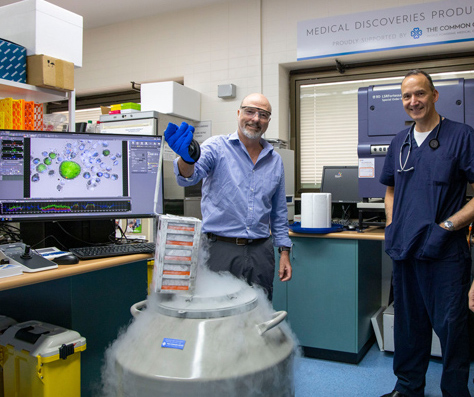
Dr Simon Apte with Professor Dan Chambers
A simple microscopic technique for quantifying the alveolar crystal burden in bronchoalveolar lavage (BAL) fluid will help differentiate patients with silicosis from those with other respiratory disorders, Australian researchers say.
As well as the potential to improve the clinical management of silicosis, the test will be useful to advance understanding of the pathobiology of silica-related lung injury, they suggest.
Queensland researchers assessed their new technique in 23 artificial stone workers with a diagnosis of silicosis and eight patients with other diagnoses including sarcoidosis, obstructive sleep apnoea, asthma, and ILD.
The study, published in Respirology, found the alveolar crystal burden was greater in patients with silicosis than other conditions (0.44 v 0.057 pg/cell; p < 0.001).
Alveolar crystal burden was positively correlated with years of silica exposure (ρ = 0.49, p = 0.02).
“Although we found a positive relationship between years working as a stoneworker and alveolar crystal burden, this relationship was by no means perfect,” said the study authors, led by Dr Simon Apte of the Prince Charles Hospital, Brisbane, and the University of Queensland (UQ).
“We suggest that alveolar crystal burden, as the end result of a complex interplay between duration and intensity of exposure, composition and size of airborne particles and efficacy of intrapulmonary clearance, may better reflect the risk of developing significant lung disease, representing an important adjunct to the occupational history.”
There was also a significant inverse correlation between crystal burden and change in DLCO over time (ρ = −0.50, p = 0.015) but no significant relationship with other spirometric parameters (FEV1, ρ = −0.37, p = 0.08; FVC, ρ = −0.25, p = 0.24; FEV1/FVC, ρ = −0.26, p = 0.23).

Crystals examined by scanning EM
(top) and elemental content assessed
by energy-dispersive spectroscopy.
The study said their method requires no specialised equipment apart from a simple inverted light microscope which is common in most laboratories. It quantifies all particles within the recovered BAL fluid – mostly found to be quartz or aluminosilicates – including those found within macrophages.
“Therefore, we propose that this technique may provide a useful adjunct to assist in arriving at a final diagnosis; assessing the response to interventions, such as removal from the workplace or whole lung lavage; and in further exploring mechanistic inter-relationships between respirable crystalline silica, inflammatory lung injury and clinical disease.”
They said an important next step will be to determine whether alveolar crystal quantification or BAL lymphocytosis can predict future clinical deterioration and requirement for lung transplantation